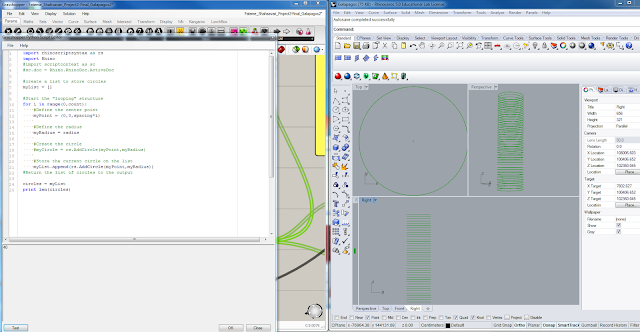1. Modeling by scripting
Python for Grasshopper is used to create "For" loops and generate the base structure for the model.
 |
| 1. Creating 40 circles for 40 floors of the building by Python scripting |
 |
| 2. The values of the parameters used in Grasshopper for the model |
 |
| 3. The overall shape of the model picking up from the Python script in Grasshopper |
2. Analyzing the site using Ladybug
Ladybug is utilized to import the weather data into Grasshopper and analyze the physical site.
 |
| 4. Importing weather file of London and visualizing the hourly data |
 |
5. Importing weather file of London and visualizing the eating and cooling degree days
|
3. Calculating Anual Sun Exposure (ASE) for LEED by Ladybug
Anual Sun Exposure (ASE) is perhaps one of the most difficult-to-understand aspects of LEED v4. ASE measures the percentage of floor area that receives more than 1000 lux of DIRECT SUN ONLY for more than 250 occupied hours per year.
 |
6. Evaluating Anual Sun Exposure (ASE) using Ladybug
 |
| 7. The result shows that this model has passed LEED for ASE |
|
4. Model Optimization using Galapagos
In this experiment, the surface area to volume ratio is tended to be minimized in order to reduce thermal heat gain/loss.
4.1 Building Shape - Surface Area to Volume Ratio
The surface area to volume (S/V) ratio is an important factor determining heat loss and gain. The greater the surface area the more the heat gain/ loss through it. So small S/V ratios imply minimum heat gain and minimum heat loss.
To minimize the losses and gains through the fabric of a building a compact shape is desirable. The most compact orthogonal building would then be a cube. This configuration, however, may place a large portion of the floor area far from perimeter daylighting.
In hot dry climates, S/V ratio should be as low as possible as this would minimize heat gain. In cold-dry climates also S/V ratios should be as low as possible to minimize heat losses. In warm-humid climates, the prime concern is creating airy spaces. This might not necessarily minimize the S/V ratio. Further, the materials of construction should be such that they do not store heat.
 |
| 8. Minimal surface area (SA) vs. maximum surface area (SA) (minimum SA leads to lower heat gain and lower heat loss) |
References:
-
- Heating, Cooling, and Lighting as Form-Givers in Architecture
 |
| 9. The original model before applying the optimization process |
 |
| 10. The setting of Galapagos for minimizing the surface area to volume ratio |
 |
11. The results after applying the Evolutionary algorithm for the best possible surface area to volume ratio
5. Project Movie
|










Comments
Post a Comment